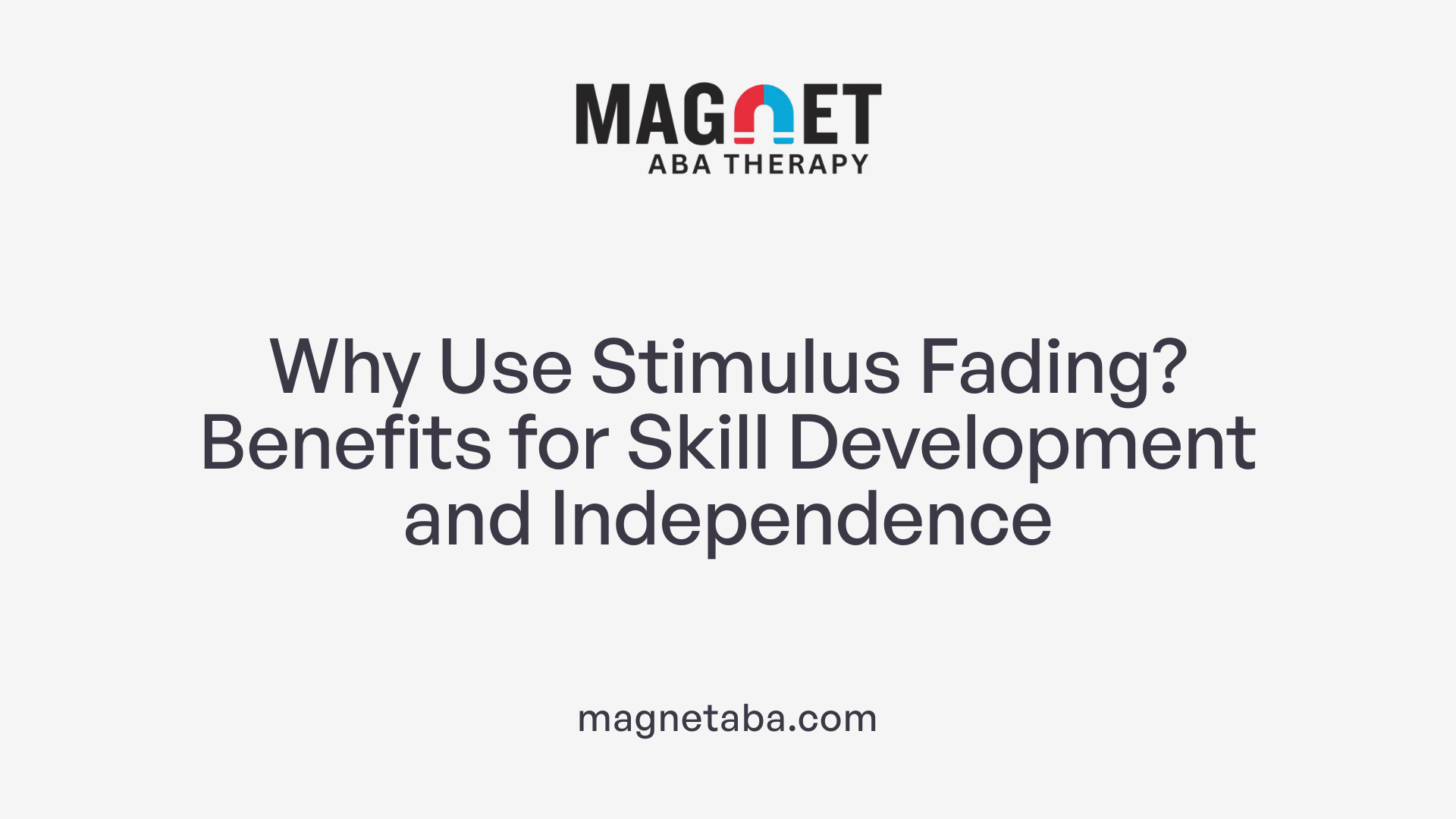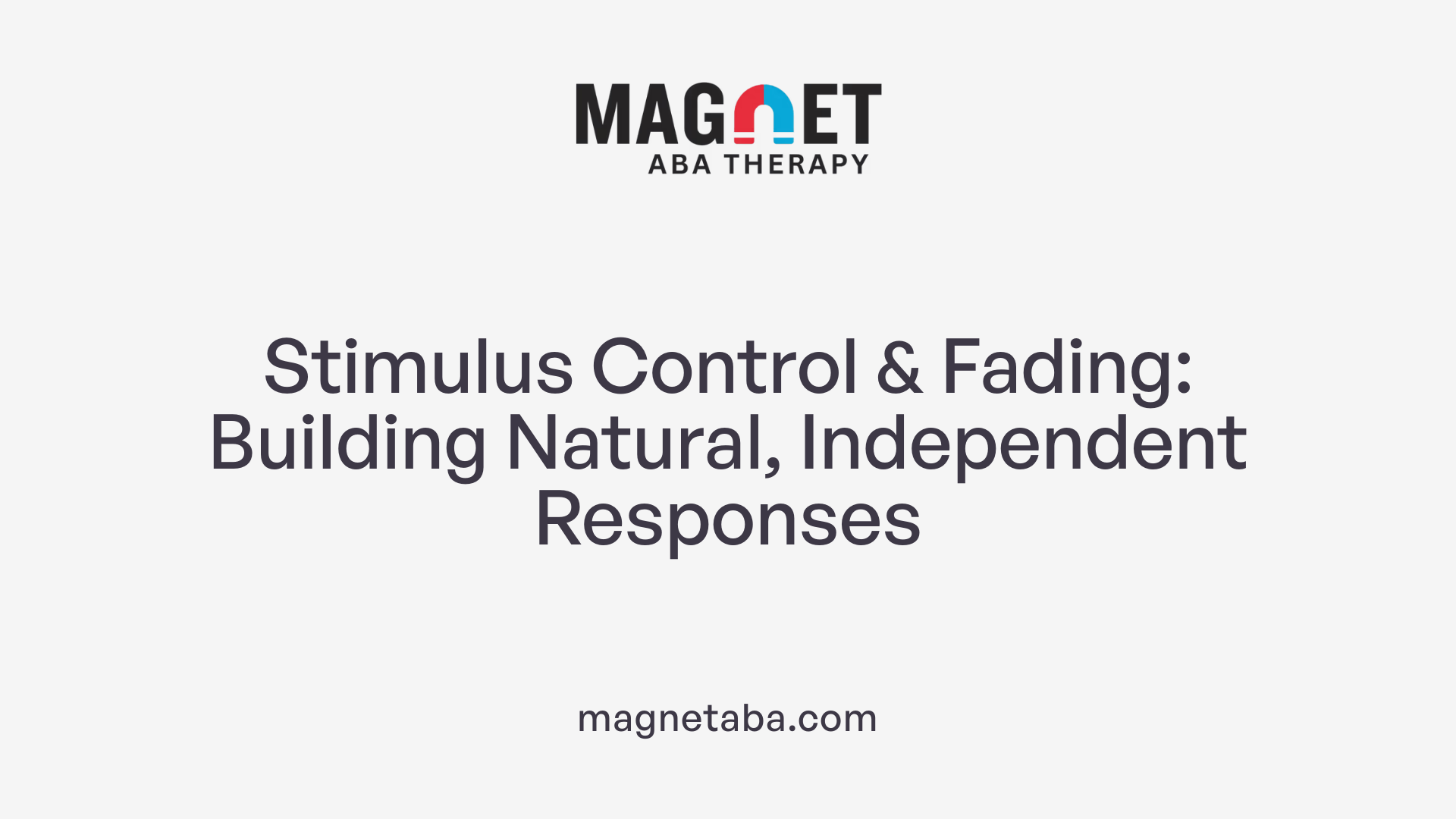Understanding the Foundations of Stimulus Fading in ABA
Stimulus fading is a fundamental behavioral intervention technique used within ABA to facilitate learning, promote independence, and ensure the generalization of skills. By gradually reducing reliance on prompts or exaggerated stimuli, individuals can transition to responding reliably to natural environmental cues, a vital step toward behavioral autonomy. This article explores what stimulus fading is, its applications in various interventions, the procedures involved, its relationship with stimulus control, and best practices for implementation.
Defining Stimulus Fading in ABA

What is stimulus fading in ABA? and how is it used in behavioral interventions?
Stimulus fading in applied behavior analysis (ABA) is a structured process that involves gradually altering the features of a stimulus to promote independent responding and transfer control from prompts or exaggerated cues to natural or targeted stimuli.
The technique works by systematically changing elements such as the size, intensity, shape, or color of the stimuli over time. For instance, a teacher might start with a brightly colored card to help a student identify a specific item or concept. As the student becomes more proficient, the brightness or size of the card is gradually reduced until the student responds correctly without any visual aid.
This method helps in reducing reliance on external prompts, encouraging learners to respond based on natural stimuli in their environment. It is especially useful for teaching discrimination tasks—like differentiating between similar objects, identifying colors, or recognizing words—and also in addressing behaviors like food refusal or phobias.
In behavioral interventions, stimulus fading plays a vital role in promoting generalization of skills and ensuring responses are durable across different settings. For example, in exposure therapy for childhood selective mutism, stimulus fading involves slowly approaching feared stimuli, such as unfamiliar persons, to help the child gradually overcome anxiety and begin to speak.
The procedure typically begins with responses already within the learner’s repertoire and adjusts stimuli in small, manageable steps. This ensures that the individual is not overwhelmed and can acquire skills at a comfortable pace. The ultimate goal is for the learner to respond appropriately to the natural stimulus alone, without prompts or exaggerated cues.
By systematically fading prompts and modifying stimuli, ABA practitioners can foster independence, build confidence, and facilitate the generalization of learned behaviors, making stimulus fading a versatile and effective technique in behavioral support and therapy.
The Purpose and Benefits of Stimulus Fading

Why is stimulus fading important?
Stimulus fading is an essential technique in applied behavior analysis (ABA) because it helps individuals develop greater independence and skill versatility. It involves the gradual reduction or alteration of stimuli prompts to shift response control from artificial cues to natural environmental stimuli. This process ensures that behaviors are not solely dependent on external aids, which can limit real-world application. For example, in teaching a child to identify colors or perform daily tasks, starting with exaggerated prompts or prominent stimulus features—like bright colors or large objects—helps the individual respond correctly.
As the individual demonstrates proficiency, these prompts are systematically faded. Changing attributes such as size, intensity, or shape of the stimulus makes the task more natural. This process leads to generalized response patterns that are more likely to be displayed in everyday settings. Effective stimulus fading therefore helps bridge the gap between structured teaching environments and real-world situations, promoting functional independence.
How does stimulus fading enhance skill acquisition and independence?
Stimulus fading assists in skill acquisition by transferring stimulus control from prompts or artificial cues to natural stimuli found in real-life contexts. By gradually reducing prompts—using procedures like most-to-least prompting or prompt delay—and modifying stimulus properties such as color or shape, individuals learn to respond correctly without relying on external assistance.
This gradual process not only encourages accurate responses but also strengthens intrinsic motivation and confidence. For example, a learner who initially responds to a brightly colored card can be gradually transitioned to responding to standard items in the environment, like recognizing a standard plate or a real object rather than a cue card.
Over time, this exposure fosters independent responding, reduces dependence on prompts, and enhances the learner’s ability to generalize skills. Studies show that systematic fading of stimuli results in more durable and functional skills, enabling individuals—especially those with autism spectrum disorder (ASD)—to perform tasks in diverse settings, thereby increasing their overall autonomy.
Impact of stimulus fading on independence
Research indicates that stimulus fading significantly impacts independence by helping individuals rely on natural cues rather than artificial prompts. For example, in medical settings, gradual fading of physical prompts during blood glucose monitoring allowed a child with autism to perform blood draws independently.
Similarly, everyday skills like putting away clothes or choosing objects become more automatic as stimuli cues are systematically reduced. This technique promotes self-initiation, reduces prompt dependency, and encourages learners to respond appropriately in various contexts, leading to broader generalization.
In summary, stimulus fading is not just a teaching aid but a facilitator of meaningful skill development and autonomous functioning. It ensures behaviors are adaptable, durable, and applicable beyond structured environments, empowering individuals with greater control over their behaviors and lives.
Procedures, Techniques, and Examples of Stimulus Fading
 What procedures and techniques are used in stimulus fading?
What procedures and techniques are used in stimulus fading?
Stimulus fading involves systematically decreasing the prominence or intensity of a stimulus or prompt to transfer control to a natural or criterion stimulus. Procedures typically start with a highly salient or exaggerated stimulus and then gently reduce aspects such as size, intensity, proximity, or artificial features in a step-by-step manner.
Techniques include modifying stimulus features over successive trials, such as fading prompts (e.g., moving prompts further away or reducing their intensity), or gradually changing stimulus properties like texture, size, or form to promote discrimination and independent responding.
This method is used across various contexts, including teaching discrimination skills, reducing prompt dependency, and therapy for feeding or mutism, by fading prompts or stimuli until the individual responds reliably to the criterion stimulus alone. The process emphasizes a gradual, systematic approach to encourage independent behavior without abrupt changes or abrupt removal of support.
Can you provide examples of stimulus fading?
A common example involves teaching color identification: initially highlighting a bright green color with a vivid ink or background, then progressively reducing the brightness or intensity until the individual can identify the color without additional cues.
Another example is in teaching a child to put away clothes, where a parent might initially use a brightly colored marker or line on drawers to prompt the action. Over time, the marker or line is faded until the child can put away clothes independently based on the natural appearance of their drawers.
Stimulus shaping is also a form of stimulus fading specifically focused on altering the form or shape of a stimulus to eventually match the target stimulus. For instance, starting with a picture resembling a car and gradually transforming it into standard text helps the learner recognize the word without reliance on the initial shape.
Overall, stimulus fading facilitates independence by gradually reducing reliance on prompts and allowing behaviors to be elicited by natural stimuli, promoting generalization and skill mastery across various settings.
Understanding Stimulus Control and Its Relationship to Fading

What is stimulus control?
Stimulus control happens when a specific stimulus consistently influences the likelihood that a behavior will occur. For example, a child might only say "hello" when they see a smile, indicating that their response is under stimulus control of the smiling face.
In therapy and learning contexts, establishing stimulus control means teaching individuals to respond appropriately to legitimate cues, naturally occurring stimuli, or signals, rather than just prompts. This skill is essential for generalization, meaning that learned behaviors transfer smoothly across different settings and situations.
How does stimulus fading relate to stimulus control?
Stimulus fading is a deliberate technique used within Applied Behavior Analysis (ABA) to promote stimulus control. It involves gradually modifying characteristics of a stimulus—such as making it less bright, smaller, or less close—while the behavior is still being performed correctly. This systematic reduction helps the individual learn to recognize and respond correctly to the natural, less salient stimulus without reliance on the more prominent, artificial cues.
For instance, a teacher might initially teach a child to respond to a brightly colored card. Over time, the brightness is faded, then the card's size is reduced, and finally, the response is prompted only by the natural stimulus—like the actual object in real life. This gradual change transfers stimulus control from an artificial prompt to the environment itself, leading to more natural and independent responses.
Both stimulus control and stimulus fading are fundamental in skill acquisition, especially for individuals with autism. Using fading techniques ensures that responses are not dependent on prompts but are instead triggered by real-world stimuli, promoting better generalization and autonomy.
Best Practices and Strategies for Effective Implementation
What are best practices for implementing stimulus fading?
Implementing stimulus fading effectively requires a structured and gradual approach. Start by selecting stimuli or prompts that reliably evoke the desired response, ensuring that the individual is attentive to relevant stimuli. It's essential to introduce stimuli that are initially prominent or exaggerated, such as using brightly colored cards or physical guidance, to facilitate initial learning.
Next, systematically reduce or modify these prompts or stimuli over time. This can involve moving prompts out of sight, decreasing their intensity, or increasing the response requirements. For example, a teacher might initially use physical prompts and then gradually shift to visual cues before prompting the individual to respond independently.
Reinforcement plays a crucial role throughout the fading process. Providing positive reinforcement for correct responses helps to strengthen the behavior and encourages the individual to respond accurately without support. This reinforcement should be carefully timed and consistent, aligned with the fading schedule.
In addition, discrimination training and the use of natural cues help support generalization of skills. Encouraging responses to natural stimuli prepares the individual for real-world environments. It’s also important to monitor progress closely; regularly assessing performance allows practitioners to identify when to modify the fading steps.
Finally, clear, systematic changes in stimulus characteristics—such as intensity, size, or shape—are vital. Ensuring that each step in the fading process is manageable prevents frustration and promotes confidence. Overall, the main goal is to transfer control from prompts or artificial stimuli to natural, real-world stimuli, fostering independent and functional behaviors.
Concluding Thoughts on Stimulus Fading in ABA
Stimulus fading remains a vital, versatile tool in ABA that promotes autonomous, functional behaviors by gradually transferring stimulus control from prompts or exaggerated stimuli to natural cues. When implemented systematically with patience and consistency, stimulus fading enhances skill acquisition, supports generalization across settings, and fosters independence. Proper understanding and adherence to best practices ensure meaningful and lasting behavioral change, making stimulus fading an indispensable technique in effective behavioral interventions.
References
- Stimulus Fading - an overview | ScienceDirect Topics
- Stimulus fading - Pass the Big ABA Exam Glossary
- What is Stimulus Fading in ABA? - BehaviorPREP
- What Fading in ABA is All About -
- Stimulus Fading and Response Elaboration in Differential ...
- Stimulus Fading - ABA Study Guide
- 6e.G-8: Design and implement procedures to fade stimulus and ...
- Stimulus Fading and Differential Reinforcement for the Treatment of ...
- The Role of Prompting and Fading in Establishing Stimulus Control ...











